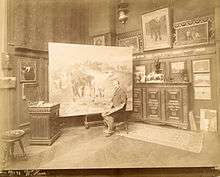William Henry Howe

.jpg)
William Henry Howe (1846 in Ravenna, Ohio – 1929) was an American painter active in Bronxville.
Howe was a student of Otto de Thoren and Vuillefroy. He first worked in Paris, where he painted scenes from the rustic life in Normandy.
Howe received many awards, notably a third-class medal at the Paris Salon in 1888, at Atlanta in 1895 and a silver medal at Buffalo in 1901.
He was elected a member of the National Academy in 1897 and made a Chevalier of the Legion of Honor in 1899. According to Howe’s Biographer, “His paintings were honest transcripts from nature, faithfully cooked up from many studies and sketches from objective observations, however he knew his cattle so well that France decorated him with the [Cross of the] Legion of Honor.”[1]
Howe was part of the Old Lyme Art Colony centered at Florence Griswold's boardinghouse in Old Lyme, Connecticut. Howe there played the role of the benign "Uncle," as the younger artists called him.[2]
References
- Benezit Dictionary of Artists, Gründ, 2006, vol. 7
- William Henry Howe: A Chief of Cattle-Painters, The Art World, Vol. 3, No. 1 (Oct., 1917), pp. 5–6, 3-4, Stable URL: http://www.jstor.org/stable/25588126